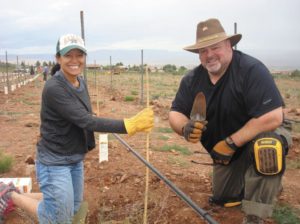 As clouds wash over the Verde Valley on a drizzly spring day, Nikki Bagley shakes the dirt from her gloves and offers a smile of satisfaction.
As clouds wash over the Verde Valley on a drizzly spring day, Nikki Bagley shakes the dirt from her gloves and offers a smile of satisfaction.
“We’re planting tannat today, which is a minor Bordeaux blending varietal,” she said above the sounds of raking and shoveling. “It’s very dark and tannic so it can be a good stand alone wine – it is age-able and sturdy – or it can be used to beef up a lighter-bodied wine.”
Bagley is the director of Yavapai College’s viticulture program. Joining her in the nutrient rich soil of Cottonwood’s rolling Black Hills are dozens of volunteers and students who want to learn about the wine business from the ground up.
John Henderson moved from Boulder, Colorado for the hands-on experience. “My ultimate goal is to be a winemaker someday,” he said after planting his first vine. “I started taking online classes through Yavapai College and after the first semester I convinced my wife to pack up and move down to Arizona and start here.”
Bagley says interest in the wine making potential of the Verde Valley has grown far beyond the 12th acre the school has planted. In fact, she says the wine industry reaps an estimated $50-million economic impact for the area annually.
“The soils that we see in the Verde Valley are mineral rich clays, volcanic clays, and then we have high calcium and high magnesium soils, which tend to be really great for minerality in wine, but they also tend to be deficient in micro nutrients, which can limit your production and so you have to do some amending.”
Bagley sends soil samples to a lab to find out whether minerals like nitrogen, phosphorous or potassium are present and what kind of amendments might be added to produce the best harvests. She says each vine is spaced evenly to receive the same amount of sunshine, for consistency. The vineyard is irrigated with a drip system using A+ rated reclaimed water from Cottonwood. And insects are monitored.
“In this vineyard, we’ve got a ton of ladybugs and lacewings. There are parasitic wasps and all sorts of other beneficial insects that we’re lucky to have naturally here.”
Bagley says climate is a key ingredient in the wine making process, as well, as it is important to avoid winter kill and spring frost. “In Arizona, we are balancing heat and cold. The Verde Valley is the sweet spot because we have mountains and a river and the Mogollon Rim draining cold air. Our nighttime temperatures are nice and cool. We get color build up, we get acid retention from that.”
The college planted its first vineyard in 2010. “The story behind why we started this went back to a legislative decision. In 2005, our legislature approved a measure that was fabulous for small-scale growers and that was the ability to direct market your wine through a tasting room. There wasn’t a way to tax it before, so you had to move through a distributor, which really didn’t leave an economic option for boutique wineries because they really didn’t have that profit margin. So, in 2005, that was passed and really opened the door to the Verde Valley’s wine industry.”
She says the college was approached by the Wine Consortium to support the emerging industry with a viticulture program, which could help people who were buying land for vineyards be successful in their investments and also train a knowledgeable workforce of vineyard managers, growers and sales consultants.
The college answered the call by offering classes in 2009. It also transformed its racquetball courts into a winery. Since it can take nearly a decade before a profitable vineyard ripens, source grapes from California are being used in the meantime so wine can pour and cash can flow.
“We wanted our students to have a business model experience and manage a vineyard throughout every step of establishment.”
Students learn how to be farmers, horticulturists, soil scientists, entomologists and marketers as they grow and harvest grapes, produce wine, create labels, manage the tasting room and sell the product. The program currently has about 100 students enrolled, a number Bagley says is healthy, but one she expects to double.
“We see a lot of students driving from the Phoenix area, over from Prescott and down from Flagstaff. We’re trying to be a resource for the entire Southwest.”
That’s the big viticulture picture for Yavapai College in the pastoral Verde Valley. The smaller, but very important immediate snapshot concerns the tannat crop in acre 12.
“It sounds simple to dig a hole and throw a plant in there, but you have to be careful,” said Henderson. “You’ve got to make sure you learn how to set the roots right so they don’t grow up out of the ground.”
The tannat is expected to produce its first leaf this summer with its first harvest in about four years. FBN
By Bonnie Stevens, FBN
Photo by Bonnie Stevens





